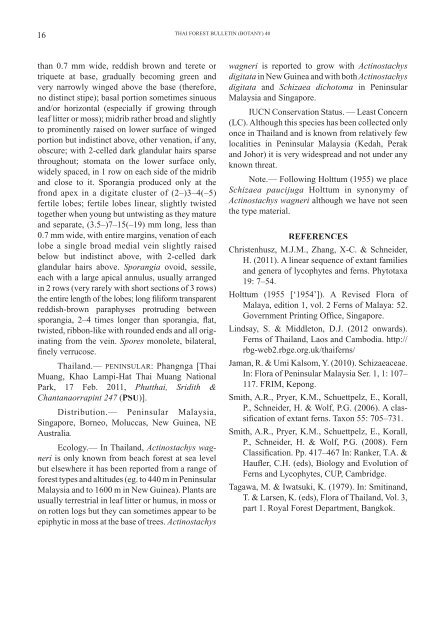Thai Forest Bulletin
Thai Forest Bulletin
Thai Forest Bulletin
You also want an ePaper? Increase the reach of your titles
YUMPU automatically turns print PDFs into web optimized ePapers that Google loves.
16<br />
than 0.7 mm wide, reddish brown and terete or<br />
triquete at base, gradually becoming green and<br />
very narrowly winged above the base (therefore,<br />
no distinct stipe); basal portion sometimes sinuous<br />
and/or horizontal (especially if growing through<br />
leaf litter or moss); midrib rather broad and slightly<br />
to prominently raised on lower surface of winged<br />
portion but indistinct above, other venation, if any,<br />
obscure; with 2-celled dark glandular hairs sparse<br />
throughout; stomata on the lower surface only,<br />
widely spaced, in 1 row on each side of the midrib<br />
and close to it. Sporangia produced only at the<br />
frond apex in a digitate cluster of (2–)3–4(–5)<br />
fertile lobes; fertile lobes linear, slightly twisted<br />
together when young but untwisting as they mature<br />
and separate, (3.5–)7–15(–19) mm long, less than<br />
0.7 mm wide, with entire margins, venation of each<br />
lobe a single broad medial vein slightly raised<br />
below but indistinct above, with 2-celled dark<br />
glandular hairs above. Sporangia ovoid, sessile,<br />
each with a large apical annulus, usually arranged<br />
in 2 rows (very rarely with short sections of 3 rows)<br />
the entire length of the lobes; long fi liform transparent<br />
reddish-brown paraphyses protruding between<br />
sporangia, 2–4 times longer than sporangia, fl at,<br />
twisted, ribbon-like with rounded ends and all originating<br />
from the vein. Spores monolete, bilateral,<br />
fi nely verrucose.<br />
<strong>Thai</strong>land.— PENINSULAR: Phangnga [<strong>Thai</strong><br />
Muang, Khao Lampi-Hat <strong>Thai</strong> Muang National<br />
Park, 17 Feb. 2011, Phutthai, Sridith &<br />
Chantanaorrapint 247 7 ( PSU)].<br />
Distribution.— Peninsular Malaysia,<br />
Singapore, Borneo, Moluccas, New Guinea, NE<br />
Australia.<br />
Ecology.— In <strong>Thai</strong>land, Actinostachys wagneri<br />
is only known from beach forest at sea level<br />
but elsewhere it has been reported from a range of<br />
forest types and altitudes (eg. to 440 m in Peninsular<br />
Malaysia and to 1600 m in New Guinea). Plants are<br />
usually terrestrial in leaf litter or humus, in moss or<br />
on rotten logs but they can sometimes appear to be<br />
epiphytic in moss at the base of trees. Actinostachys<br />
THAI FOREST BULLETIN (BOTANY) 40<br />
wagneri is reported to grow with Actinostachys<br />
digitata in New Guinea and with both Actinostachys<br />
digitata and Schizaea dichotoma in Peninsular<br />
Malaysia and Singapore.<br />
IUCN Conservation Status. — Least Concern<br />
(LC). Although this species has been collected only<br />
once in <strong>Thai</strong>land and is known from relatively few<br />
localities in Peninsular Malaysia (Kedah, Perak<br />
and Johor) it is very widespread and not under any<br />
known threat.<br />
Note.— Following Holttum (1955) we place<br />
Schizaea paucijuga Holttum in synonymy of<br />
Actinostachys wagneri although we have not seen<br />
the type material.<br />
REFERENCES<br />
Christenhusz, M.J.M., Zhang, X-C. & Schneider,<br />
H. (2011). A linear sequence of extant families<br />
and genera of lycophytes and ferns. Phytotaxa<br />
19: 7–54.<br />
Holttum (1955 [‘1954’]). A Revised Flora of<br />
Malaya, edition 1, vol. 2 Ferns of Malaya: 52.<br />
Government Printing Offi ce, Singapore.<br />
Lindsay, S. & Middleton, D.J. (2012 onwards).<br />
Ferns of <strong>Thai</strong>land, Laos and Cambodia. http://<br />
rbg-web2.rbge.org.uk/thaiferns/<br />
Jaman, R. & Umi Kalsom, Y. (2010). Schizaeaceae.<br />
In: Flora of Peninsular Malaysia Ser. 1, 1: 107–<br />
117. FRIM, Kepong.<br />
Smith, A.R., Pryer, K.M., Schuettpelz, E., Korall,<br />
P., Schneider, H. & Wolf, P.G. (2006). A classifi<br />
cation of extant ferns. Taxon 55: 705–731.<br />
Smith, A.R., Pryer, K.M., Schuettpelz, E., Korall,<br />
P., Schneider, H. & Wolf, P.G. (2008). Fern<br />
Classifi cation. Pp. 417–467 In: Ranker, T.A. &<br />
Haufl er, C.H. (eds), Biology and Evolution of<br />
Ferns and Lycophytes, CUP, Cambridge.<br />
Tagawa, M. & Iwatsuki, K. (1979). In: Smitinand,<br />
T. & Larsen, K. (eds), Flora of <strong>Thai</strong>land, Vol. 3,<br />
part 1. Royal <strong>Forest</strong> Department, Bangkok.
















